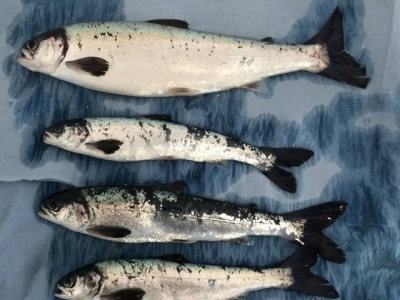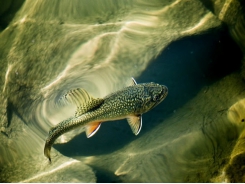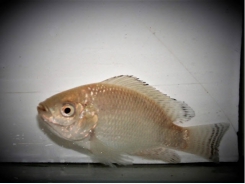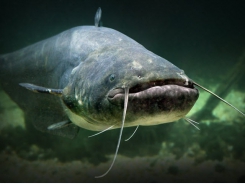How to optimise smolt survival at the marine transfer stage

Ensuring smolt adapt successfully after transfer to marine sites is notoriously difficult, but Virginia Iglesias of the Fish Vet Group offers some valuable insights into failed smolt syndrome and how to minimise it.
Examples of failed smolts beneath a healthy fish, which has correctly adapted to marine conditions
The failure to adapt between freshwater (hypo-osmotic medium) and seawater conditions (hyper-osmotic medium) and return to normal feed, due to either inadequate fish development or alteration of osmoregulatory capacity in smolts, constitutes one of the main causes of losses in farmed Atlantic Salmon (Salmo salar). The potential causes of this syndrome are complex and not yet fully understood, with no simple recommendations on how to address the problem. However, optimisation of certain conditions during the freshwater stage and at transfer can reduce the risk of failures and provide the fish with the best start at sea.
What are failed smolts?
Also known as “growth-stunted” fish, “failed smolts” are individuals that fail to feed after being transferred to sea from a freshwater source. This condition is characterised by progressive loss in fish body weight, poor condition and emaciation. Affected fish tend to hang near the surface of the sea pens, often starting around three weeks after transfer and, in particular, at 7-9 weeks post-transfer, not presenting any swimming activity. Although they still appear to have an appetite, this problem makes affected smolts unable to compete for feed with healthier individuals. Eventually, these fish can die of starvation and/or other concomitant problems.
Background and causes
The number of fish affected by failed smolt syndrome is variable – and depends on several biological, environmental, and management factors – and so are the losses associated with it. For example, failure smolt have been reported more often when fish have been transferred from freshwater tanks to commercial sea cages, compared to transfers from freshwater tank to seawater tank or freshwater cage to seawater cage. Farmed S0 populations (fish transferred to sea in the calendar year they hatched) can be more prone to failures compared to S1s (those transferred to sea in January-June in the year after they’ve hatched). There does not appear to be a direct association between the size of the fish pre-transfer and appetite post-transfer. However, a large size differential within a population at the time of sea transfer can make it hard for farmers to offer the appropriate pellet size and makes failing smolts more likely.
Several factors can lead to failure in the osmoregulatory process – both directly after transfer to seawater and in the period just after the populations have been transferred to a new environment. The time of transfer appears to be a major determinant, with salmon smolts transferred to sea either prematurely (before the beginning of the physiological transfer window) or too late (while exceeding their window) commonly presenting reduced osmoregulatory ability in saltwater. Interestingly, as reported in experimental studies, failed smolts resume normal feeding and regain weight if transferred back to freshwater.
Health and stress factors during transfer can also have a negative impact on the osmoregulation process. This condition appears to be related to general feed intake rather than to an inability to digest the feed taken, which would primarily rule out gastrointestinal abnormalities. However, previous disease challenges – such as Saprolegnia, rainbow trout fry syndrome (RTFS) or enteric redmouth disease (ERM) – or injuries – such as active fin erosion, shortened opercula – may predispose fish to osmoregulatory problems when transferred to sea. Smolts undergo major physiological and anatomical changes during smoltification, linked to a high metabolic cost. Stressful situations occurring during smoltification – such as disease outbreaks, vaccination, grading or fish movements – or concomitant diseases – such as infectious pancreatic necrosis (IPN) or poxvirus infections (SGPV) – can have a negative impact on the normal physiology of the fish populations.
Other causes reported include the genetic background of the fish populations (such as triploidy), hormone-mediated factors, water temperature, photoperiod (for S0 populations) and environmental conditions in the sea site, such as changes in water chemistry, turbidity and flows.
Pancreas and pyloric caeca histological section (H&E) – Minimal mesenteric fat between the exocrine pancreatic tissue and depletion of zymogen granules in the exocrine acinar cells
Clinical signs and lesions
Failed smolts are characterised by their thin appearance, a generally poor body condition and a reduction in body weight, while general skin darkening and variable scale loss are also both commonly seen. Affected fish tend to exhibit slow or absent swimming, hanging in the surface of the corners and sides of the pens, with poor or no response to feeding, unable to compete against healthier and larger fish. Individuals are generally easy to be netted out.
Internally, affected fish lack feed in their digestive tracts, present a significant decrease in visceral fat deposits (particularly evident in the pyloric caeca), have full gall bladders, white or yellow material in their intestine and even atrophy of the abdominal organs.
Histologically, common signs include depletion of fat reserves, particularly evident in the pyloric caeca/pancreas and skin/muscle sections, and an increased number of melanin and lipofuscin deposits in the interstitium of the spleen and kidney.
Histological section (H&E) of a failed smolt's kidney: large numbers of melanin deposits are visible in the renal interstitium
Prevention
Minimising the impact that saltwater transfer has on smolt populations, including thorough pre-transfer health assessment, avoidance of stress pre- and post-transfer, and ensuring optimal rearing conditions in commercial sea cages are essential. A reduction in smolt size variability prior to seawater transfer is also very important. In the event of a production shortfall, the use of poorer grade fish to make up numbers is often a false economy that can lead to more failing smolts. Ensuring an appropriate starvation period prior to sea transfer, short crowding times, minimal changes in water temperature and adequate water conditions during transport can benefit the status of the populations during the transfer too.
Once in pens, feed presentation, feeding times and distribution should be suitable, so that feed is readily available to all fish. This should minimise aggressive dominance behaviour, provide a larger feeding area and, therefore, improve pellet availability for those initially non-feeding fish. Strict biosecurity and the early removal of runts is highly advisable, as these can be particularly vulnerable to infectious agents and represent a source of pathogens to the wider fish populations.
Related news
Tools

Phối trộn thức ăn chăn nuôi

Pha dung dịch thủy canh

Định mức cho tôm ăn

Phối trộn phân bón NPK

Xác định tỷ lệ tôm sống

Chuyển đổi đơn vị phân bón

Xác định công suất sục khí

Chuyển đổi đơn vị tôm

Tính diện tích nhà kính

Tính thể tích ao




 Processor expansion helps catfish farmers
Processor expansion helps catfish farmers  We now understand at a molecular level how…
We now understand at a molecular level how…